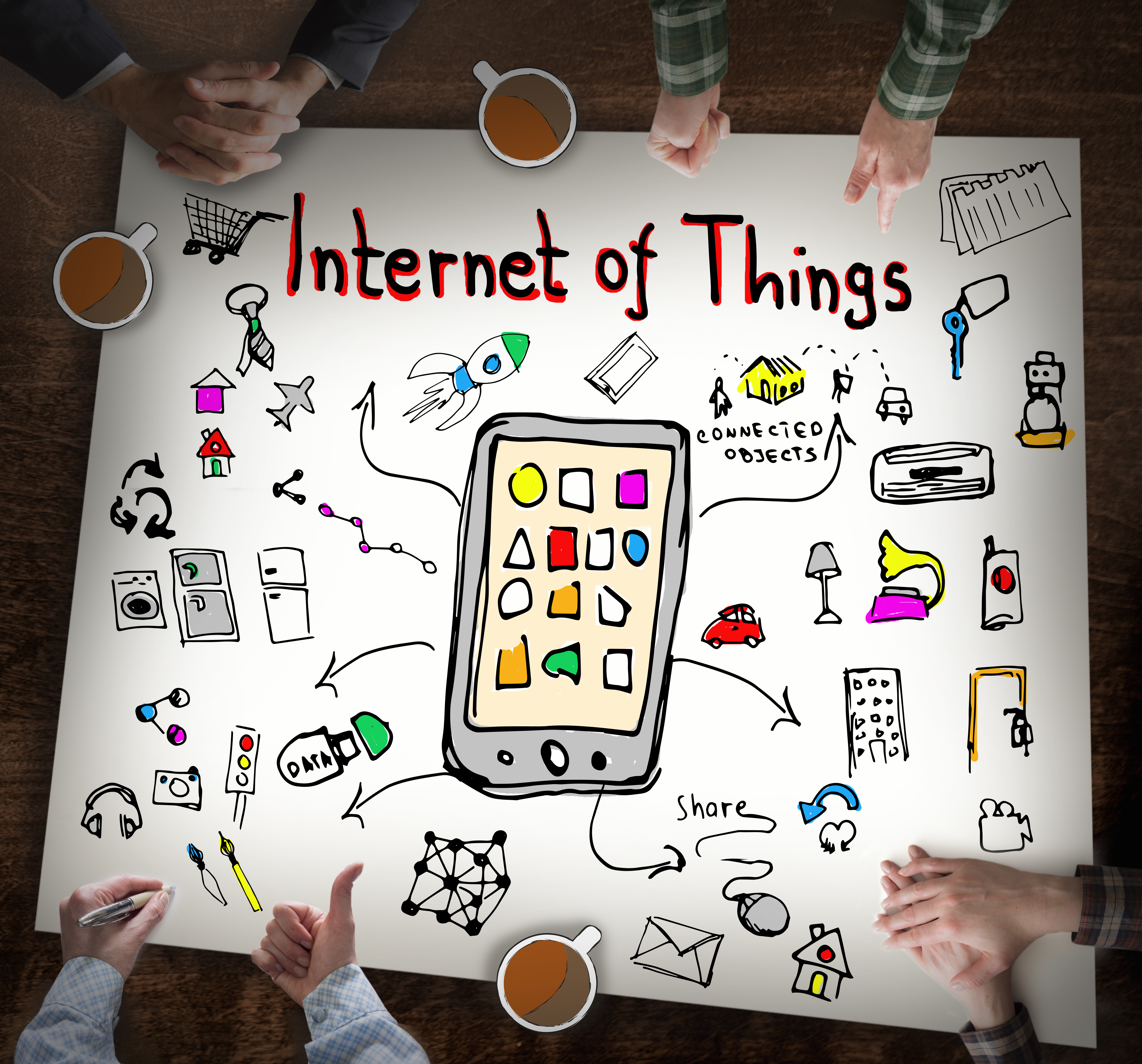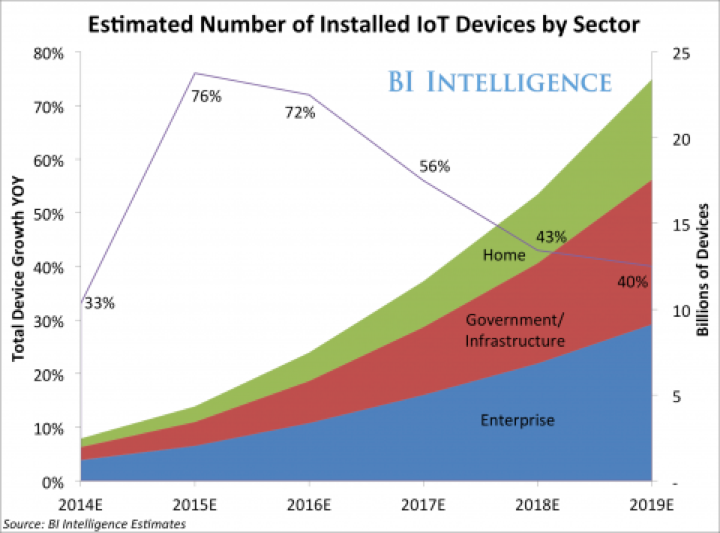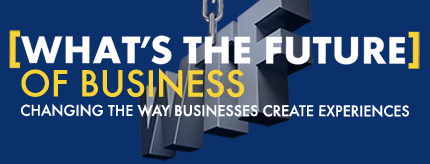The Internet of Things (IoT) is so much more than smart refrigerator that tell you when you need to go to the grocery store, wearables that track your steps or the smart watches you’re thinking about not getting. It’s the nervous system that sends and tracks important information between things, places and people.
From smarter industrial applications to cities to health care to home automation to automobiles and everything in between, IoT is changing not only your personal life, but offers great opportunities for innovation in business right now. In fact, by 2020, an estimated 50 billion devices around the globe will be connected to the Internet. Postscapes estimates the potential economic impact by 2020 will range from about US$2 trillion to more than $14 trillion. And, that’s just a few years away!
As you can see in the graph below, according to BI Intelligence, the Internet of Things will be the largest device market in the world. And, IoT will result in $1.7 trillion in value added to the global economy in 2019.
Everything talks to everything and people learn about what was previously invisible or unattainable before. There’s much to learn in the process. But one of the areas of low hanging fruit for businesses in IoT is exploring how connected devices, people and processes can increase efficiency and lower costs within the home, city, and workplace.
According to Frank Burkitt writing for Strategy+Business, one in every six businesses will roll out an IoT-based product. Roughly 75% of them are currently exploring how to use the IoT to improve internal operations and services. More so, IoT is also set to revolution the customer experience by helping companies personalize or customize products and services based on data and behavior sent directly by customers by using connected products or wading through connected places.
The result is innovation across the board.
The question is, how will your company build value in this new world and what role will you play in its transformation?
For starters, let’s take a broad yet organized view of how the emerging landscape of IoT players. They tend to fall into one of three camps with each reflecting a different type of enterprise as Burkitt learned.
1) Enablers: Develop and implement the underlying technology. Enablers are primarily technology-oriented companies, such as Cisco, Google, HP, IBM, and Intel. These vendors essentially build and maintain the IoT infrastructure that enables Engagers to develop their own connected services.
2) Engagers: Design, create, integrate, and deliver IoT services to customers. Engagers offer the direct link between IoT and the market. They use the endpoint, hub, platform, and service offerings (the IoT infrastructure) created by the Enablers to produce services for consumers and businesses.
3) Enhancers: Devise their own value-added services, on top of the services provided by Engagers. These companies provide integrated services that reframe and repackage the products and services of the Engagers. Their value proposition stems from creating and extracting value from the data, relationships, and insights generated from IoT devices and activity.
As IoT grows, the implications for business model innovation are huge. But that’s just the beginning. Opportunities for innovation and optimization in customer and employee engagement, product development, services and overall experience design is largely unwritten and yours to define. All it takes is to not only explore where you want to be and what you want to do but also think shift your perspective to see it in two ways: 1) Where you add value and to whom and 2) Where and how can you capture value to improve company efficiencies, identify opportunities, and learn. Like with anything new, we can either innovate or embrace mediocrity. And as competitors explore these new horizons, your competitive advantage comes down not to technology but how you will employ it to improve what exists and introduce what has yet to be realized.
Connect with me… Twitter | LinkedIn | Facebook | Youtube | Instagram | Pinterest
IoT Photo Credit: Shutterstock








I like your concepts of Engagers and Enhancers. It raises
the possibilities of experience execution that looks beyond the confines of an
IoT-enabled device or service. I could imagine that if the API is exposed by
the Engager’s product/service, that enables others to pick up feeds from it and
combine the data from other Engagers to create more connected experiences. Conceptually
it sounds like an enabler of the “business moment” idea put forth by Gartner. Interesting
ideas and exciting times ahead!
We host the Oxford IoT group as they have synergy with our DataScience Oxford and Develop Oxford Groups. I see the future with IoT producing data which fuels clever algorithms which then deliver insight or action to mobile devices – IoT>DataScience>Develop>User.
This has profound impact on customer experience. In a world where data is constantly informing them in clever ways how to do things, what is on offer etc. they will be almost totally immune to the marketing message. Marketers will have to be driving this useful insight or action and making their products or services totally relevant to a world of one – no two people will get the same data.
That’s exactly right…
Perhaps the value we might all secure from the IoT pivots on whether
it’s of the [insert brand name here]-IoT or citizen-centric-IoT variety.
Will it be intermediated toll bridge style, or as open and
decentralized as the original architects of the Internet envisaged 46
years ago, and as Berners-Lee envisaged for the Web 26 years ago?
Does this purview of enabler / engager / enhancer accommodate the citizen-centric variety?
At
the hi:project we contend that a citizen-centric IoT creates more value
for everyone faster, while also helping avoid some of the dystopian
potential. And everyThing gets an interface when the citizen brings her
own, an interface that also represents the locus of her personal data
and nexus of her privacy preferences.
Thank you for sharing Philip!
At the end of the day they must recognize that all of the fancy technology they create or build must still be about appealing to the guy and girl on the street. 🙂
true dat